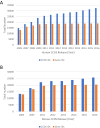Consensus coding sequence (CCDS) database: a standardized set of human and mouse protein-coding regions supported by expert curation
- PMID: 29126148
- PMCID: PMC5753299
- DOI: 10.1093/nar/gkx1031
Consensus coding sequence (CCDS) database: a standardized set of human and mouse protein-coding regions supported by expert curation
Abstract
The Consensus Coding Sequence (CCDS) project provides a dataset of protein-coding regions that are identically annotated on the human and mouse reference genome assembly in genome annotations produced independently by NCBI and the Ensembl group at EMBL-EBI. This dataset is the product of an international collaboration that includes NCBI, Ensembl, HUGO Gene Nomenclature Committee, Mouse Genome Informatics and University of California, Santa Cruz. Identically annotated coding regions, which are generated using an automated pipeline and pass multiple quality assurance checks, are assigned a stable and tracked identifier (CCDS ID). Additionally, coordinated manual review by expert curators from the CCDS collaboration helps in maintaining the integrity and high quality of the dataset. The CCDS data are available through an interactive web page (https://www.ncbi.nlm.nih.gov/CCDS/CcdsBrowse.cgi) and an FTP site (ftp://ftp.ncbi.nlm.nih.gov/pub/CCDS/). In this paper, we outline the ongoing work, growth and stability of the CCDS dataset and provide updates on new collaboration members and new features added to the CCDS user interface. We also present expert curation scenarios, with specific examples highlighting the importance of an accurate reference genome assembly and the crucial role played by input from the research community.
Published by Oxford University Press on behalf of Nucleic Acids Research 2017.
Figures





References
-
- O’Leary N.A., Wright M.W., Brister J.R., Ciufo S., Haddad D., McVeigh R., Rajput B., Robbertse B., Smith-White B., Ako-Adjei D. et al. . Reference sequence (RefSeq) database at NCBI: current status, taxonomic expansion, and functional annotation. Nucleic Acids Res. 2016; 44:D733–D745. - PMC - PubMed
-
- Pruitt K.D., Harrow J., Harte R.A., Wallin C., Diekhans M., Maglott D.R., Searle S., Farrell C.M., Loveland J.E., Ruef B.J. et al. . The consensus coding sequence (CCDS) project: Identifying a common protein-coding gene set for the human and mouse genomes. Genome Res. 2009; 19:1316–1323. - PMC - PubMed
Publication types
MeSH terms
Grants and funding
LinkOut - more resources
Full Text Sources
Other Literature Sources

